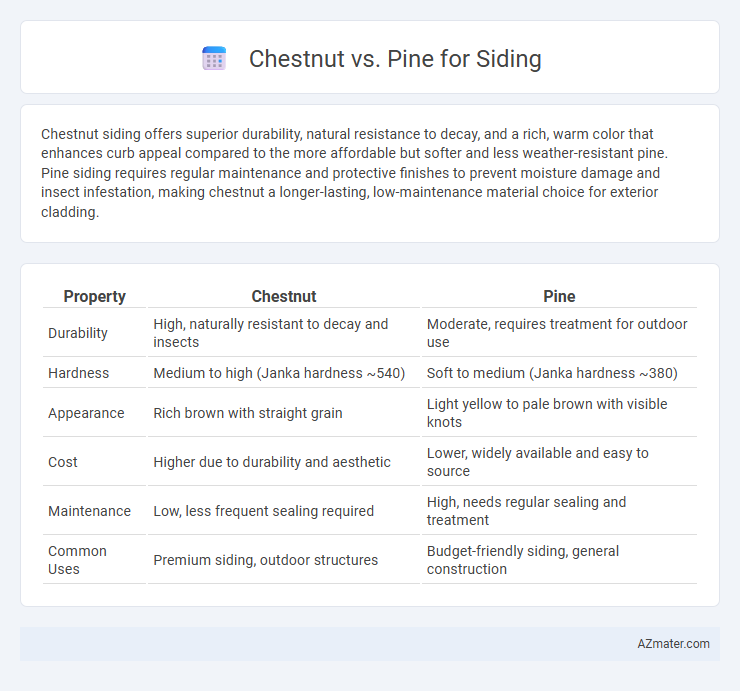Chestnut siding offers superior durability, natural resistance to decay, and a rich, warm color that enhances curb appeal compared to the more affordable but softer and less weather-resistant pine. Pine siding requires regular maintenance and protective finishes to prevent moisture damage and insect infestation, making chestnut a longer-lasting, low-maintenance material choice for exterior cladding.
Table of Comparison
| Property | Chestnut | Pine |
|---|---|---|
| Durability | High, naturally resistant to decay and insects | Moderate, requires treatment for outdoor use |
| Hardness | Medium to high (Janka hardness ~540) | Soft to medium (Janka hardness ~380) |
| Appearance | Rich brown with straight grain | Light yellow to pale brown with visible knots |
| Cost | Higher due to durability and aesthetic | Lower, widely available and easy to source |
| Maintenance | Low, less frequent sealing required | High, needs regular sealing and treatment |
| Common Uses | Premium siding, outdoor structures | Budget-friendly siding, general construction |
Introduction to Chestnut and Pine Siding
Chestnut siding offers exceptional durability and rich, warm tones that age gracefully over time, making it a popular choice for traditional and rustic home exteriors. Pine siding provides a lighter, more affordable option with a smooth texture and the ability to accept various finishes, enhancing its versatility for diverse architectural styles. Both woods require proper sealing and maintenance to maximize longevity and resistance to weather elements.
Physical Characteristics: Chestnut vs Pine
Chestnut siding offers a dense, durable grain structure with rich, warm tones and high natural rot resistance, making it ideal for longevity and aesthetic appeal. Pine siding features a lighter weight with a softer, more porous texture, characterized by pale, creamy hues that accept stains and paints easily but require regular maintenance due to its lower durability. The choice between chestnut and pine siding depends on desired durability, weather resistance, and maintenance preferences, with chestnut excelling in robustness and pine favored for cost-effectiveness and versatility.
Durability and Longevity Comparison
Chestnut siding offers superior durability compared to pine due to its dense, rot-resistant grain structure, making it highly resistant to decay and insect damage. Pine, while more affordable and easier to work with, tends to have a shorter lifespan and requires regular maintenance to prevent warping and moisture-related issues. Over time, chestnut siding can last several decades with minimal upkeep, whereas pine siding often needs replacement or extensive treatment every 10 to 15 years.
Resistance to Rot, Pests, and Decay
Chestnut offers superior resistance to rot, pests, and decay compared to pine due to its dense grain and natural tannins, which act as natural preservatives. Pine is more susceptible to insect infestations and fungal attacks unless treated with chemical preservatives, making it less durable in harsh weather conditions. Choosing chestnut for siding enhances longevity and reduces maintenance costs by providing a naturally resilient barrier against environmental damage.
Aesthetic Appeal: Grain, Color, and Texture
Chestnut siding showcases a rich, warm hue with pronounced grain patterns that create a rustic, natural aesthetic, while pine offers a lighter, more uniform color with subtle grain, lending a clean, versatile look. The texture of chestnut is generally coarse and rugged, enhancing character and depth, whereas pine's smoother texture allows for easier painting or staining to match various design preferences. Choosing between chestnut and pine for siding depends on the desired visual impact, with chestnut providing a bold, textured appearance and pine delivering a softer, more adaptable finish.
Maintenance Requirements for Each Wood
Chestnut siding requires moderate maintenance, including regular sealing and occasional staining to prevent weathering and insect damage, as its natural oils provide some resistance. Pine siding demands more frequent upkeep, such as annual painting or staining, due to its softer wood structure that is more susceptible to moisture and pest infiltration. Both woods benefit from proper installation and sealing to extend their lifespan, but chestnut generally offers greater durability with less intensive maintenance over time.
Environmental Impact and Sustainability
Chestnut siding offers superior sustainability due to its rapid growth rate and ability to sequester more carbon compared to pine, which grows slower and requires more intensive forestry management. Pine, while commonly used for siding, often involves higher chemical treatments for durability, impacting its environmental footprint negatively. Chestnut's natural resistance to decay reduces the need for harmful preservatives, making it a more eco-friendly and renewable option for sustainable building projects.
Cost Analysis: Chestnut vs Pine Siding
Chestnut siding typically incurs higher upfront costs due to its durability and resistance to decay compared to pine siding, which is generally more affordable but requires more frequent maintenance. Pine siding's lower initial price is offset by its need for periodic treatments and potential replacement, increasing long-term expenses. When evaluating cost-effectiveness, homeowners should consider the balance between chestnut's longevity and higher initial investment against pine's budget-friendly purchase cost but shorter lifespan.
Availability and Sourcing Concerns
Chestnut siding faces significant availability challenges due to the decline in American chestnut trees caused by blight, making sustainably sourced material rare and often requiring reclaimed wood. Pine siding is widely available and sourced from abundant pine forests, primarily in the southern United States and Canada, offering more consistent supply and cost-effectiveness. Builders seeking reliable and readily accessible siding materials frequently prefer pine over chestnut for its easier procurement and sustainability assurances.
Which is Better for Siding: Chestnut or Pine?
Chestnut offers superior durability and natural resistance to rot and insects, making it a long-lasting choice for siding compared to Pine. Pine is more affordable and readily available but requires regular maintenance and treatment to withstand moisture and pests. For homeowners prioritizing longevity and low maintenance, Chestnut is the better siding option; however, Pine suits those on a budget willing to invest in upkeep.

Infographic: Chestnut vs Pine for Siding
 azmater.com
azmater.com